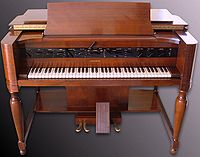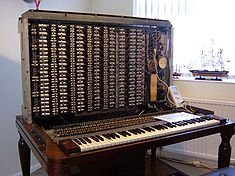- Novachord
-
Novachord
Hammond NovachordManufactured by Hammond Dates 1939 – 1942 Technical specifications Polyphony 72-voices Oscillator Divide-down LFO 6-channel electromechanical vibrato Synthesis type Subtractive analogue Filter 3-stage resonant bandpass Input/output Keyboard 72-notes The Novachord is often considered to be the world's first commercial polyphonic synthesizer.[1][2][3] All-electronic, incorporating many circuit and control elements found in modern synths, and using subtractive synthesis to generate tones, it was designed by John M. Hanert, Laurens Hammond and C. N. Williams and manufactured by the Hammond company.[4] Only some 1069 examples were built over a period from 1939 to 1942. It was one of very few electronic products released by Hammond that was not intended to emulate the sound of an organ.
Contents
History of production
While production of the Novachord began in November, 1938, it was first heard at the 1939 New York World's Fair.[5]'The Novachord Orchestra' of Ferde Grofé performed daily at the Ford stand with four Novachords and a Hammond Organ. The first instrument was delivered to President Franklin D. Roosevelt on Jan. 30, 1940 as a birthday present.
It was not well suited to the technique of organists or pianists and required frequent adjustments to controls on the front panel to create new sounds. Like many analog synthesizers, it was much better suited to producing "other worldly" timbres. The instrument found its niche some years after production, shaping the sound of many science fiction film and television scores.
Production stopped because of a shortage of parts in 1942; poor sales kept it from being built after the war.[6] It is estimated that fewer than 200 Novachords are still in existence and considerably fewer than this are still in operation. The vast majority of surviving examples are in North America although one is known to be in the UK.
Technical details
Containing 163 vacuum tubes and over 1,000 custom capacitors[7], it weighed nearly 500 pounds and was roughly the size of two spinet pianos. The divide-down oscillator architecture, based on vacuum tube monostable circuits, permitted all 72 notes to be played polyphonically by deriving several octaves of notes from twelve top-octave oscillators. A similar design was adopted in polysynths released more than 30 years later by Robert Moog and A.R.P.
The Novachord featured an early implementation of ADSR with seven attack/decay/sustain envelopes selectable by rotary switch and sustain-pedal controlled release. It also utilised a three-stage resonant band-pass filter network with variable damping and an electro-mechanical 6-channel vibrato unit operating on pairs of adjacent oscillators. The resulting sonic palette ranged from dense sustained string-like and vocal-like timbres to the sharp attack transients of a harpsichord or piano.
Despite its historical importance the Novachord did not enjoy commercial success. This was partly due to instability issues and the onset of World War II: reliability issues were caused in the main by the tight tolerances required of the operating parameters of hundreds of custom components. Hammond soon offered a special upgrade to improve stability which was no more than a low-power heater bolted inside the enclosure to reduce the effects of humidity. The instrument was not known for vacuum tube failure perhaps because the heater voltage was reduced from the normal 6.3 volts to 5 volts.
Appearances in contemporary media
Like its contemporaries, the Theremin, the Ondes Martenot and the Trautonium, it can be heard occasionally in horror and science fiction film scores including many genre films from Universal Studios and James Bernard's ethereal music for Hammer's The Gorgon (1964). Jerry Goldsmith utilised the Novachord in several of his film scores and was known to hold the instrument in high regard. It was also used for the entr'acte music in Gone With the Wind (1939).[8]
The Novachord can be heard on many recordings of the era. Many songs sung by Vera Lynn, including We'll Meet Again, were accompanied by Arthur Young on the Novachord.
References
- ^ Cirocco, Phil (2006). "The Novachord Restoration Project". CIROCCO MODULAR SYNTHESIZERS. http://www.discretesynthesizers.com/nova/intro.htm. Retrieved 26 April 2011.
- ^ Morris, Jan (1998). Manhattan '45. JHU Press. pp. 47.
- ^ Davison, Annette (2009). Alex North's A streetcar named Desire: a film score guide. Scarecrow Press. pp. 82.
- ^ Steve Howell; Dan Wilson. "Novachord". Hollow Sun. http://www.novachord.co.uk/. Retrieved 26 April 2011. See also site's 'History' page
- ^ Introduction to the Hammond Novachord
- ^ 120 Years of Electronic Music, The Hammond Novachord (1939)
- ^ Hammond Novachord. Many photos, outside and in.
- ^ Hammond Novachord Sightings.
See also
- Hammond organ
- Synthesizer
- ADSR
External links
Categories:- Synthesizers
- Electronic musical instruments
Wikimedia Foundation. 2010.




